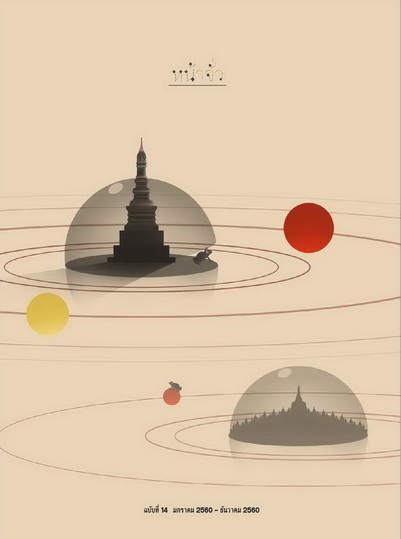การออกแบบหอพระพุทธพิริยมงคล มหาวิทยาลัยเทคโนโลยีราชมงคลธัญบุรี/ The Architectural Design of Phra Phuttha Phiriyamagala Buddha Image Hall, RMUTT
Main Article Content
Abstract
บทคัดย่อ
บทความนี้เป็นการนำเสนอผลงานสร้างสรรค์ทางสถาปัตยกรรม โดยมุ่งอธิบายความคิดอ่านและกระบวนการออกแบบหอพระพุทธพิริยมงคล หอพระประจำมหาวิทยาลัยเทคโนโลยีราชมงคลธัญบุรี อันเป็นสถาปัตยกรรมไทยแบบประเพณีประเภทหนึ่ง โดยวิธีการออกแบบประกอบด้วย 1) การศึกษาแบบแผนสถาปัตยกรรม 2) การศึกษาวิเคราะห์บริบท 3) การสร้างแนวความคิด 4) หลักการและวิธีการออกแบบสถาปัตยกรรมไทยที่นำมาใช้ และ 5) การประเมินผลและตรวจแก้ ผลงานออกแบบขั้นสมบูรณ์เป็นแบบสถาปัตยกรรมไทยประเพณีที่ก่อรูปขึ้นจากแนวความคิด “ปัญญาภาวนา” โดยมี “ดอกบัว” เป็นสื่อสัญลักษณ์ และใช้เป็นสิ่งอุปมาแก่การออกแบบรูปทรง และเครื่องประกอบทางสถาปัตยกรรมต่าง ๆ โดยมุ่งสร้างความหมายโดยนัย คือความเจริญงอกงามแห่งปัญญาจากความเพียรในการพัฒนาชีวิต ด้วยการเน้นจัดวางจังหวะขององค์ประกอบแบบก้าวหน้าที่แสดงนัยของการเปลี่ยนแปรไปในเชิงคุณภาพ เช่นเดียวกับปัญญาที่ได้รับการพัฒนาเป็นลำดับไปจนถึงขีดสุด พร้อมกับแฝงความหมายทางพุทธธรรมที่เกี่ยวข้องไว้ในลักษณะขององค์ประกอบทางสถาปัตยกรรมเหล่านั้น ได้แก่ บัวสี่เหล่า ปัญญาสาม ภาวนาสี่ อริยสัจสี่ มรรคแปด โลกุตรธรรมเก้า และโดยเฉพาะอย่างยิ่งความเพียร คือธรรมอันเป็นเครื่องนำมาซึ่งความสุขความเจริญ หัวใจของความสำเร็จสูงสุดแห่งกระบวนการพัฒนาชีวิต อันมีพระพุทธพิริยมงคลเองเป็นตัวแสดงและเป็น เครื่องยืนยันความสำเร็จสูงสุดนั้น ซึ่งก่อให้เกิดเป็นผลสัมฤทธิ์ของการออกแบบคือ เอกภาพของรูปและความหมายระหว่างองค์พระพุทธรูปกับหอพระ และการเป็นสัญลักษณ์ที่มาเสริมสร้างความหมายแห่งสถานที่แก่มหาวิทยาลัยเทคโนโลยีราชมงคลธัญบุรี อันเป็นที่ตั้งตามนัยของ “มหาวิทยาลัยแห่งดอกบัว” คือ “สถานที่แห่งการพัฒนาปัญญา”
Abstract
This article is to present the creative works of architecture that aims to explain the concept and design process of the Phra Phuttha Phiriyamagala Buddha Image Hall, the Buddha image hall of Rajamangala University of Technology, Thanyaburi. This result represented a traditional Thai architecture building type. The design method consisted of 1) studying architectural pattern, 2) analysing the context, 3) creating a design concept, 4) a principle and method used to design Thai architecture, and 5) evaluation and correction. The completed design is traditional Thai architecture that was based on the concept of “wisdom development” by “lotus” as a symbolic and a metaphor for designing architectural form and its elements. The purpose is to create the implication; that is growth in wisdom from perseverance in the development of life, by emphasis on composition with progressive rhythm, that is to imply the qualitative change, as same as the developed wisdom, sequentially to the maximum. Along with the latent meaning of Buddha-dhamma related to the feature of the architectural elements, there are 4 Lotus; the four stages distance from enlightenment, Bhanna 3; the three wisdom, Bhavana 4; the four developments, Ariyasacca 4; the four noble truths, Magga 8; the noble eightfold path, Lokuttara-dhamma 9; the nine supramundane states. Especially, the perseverance (Viriya); Dharma that brings the happiness and prosperity is the heart of the achievements of the life development process and the image of Buddha; Phra Phuttha Phiriyamangala indicate and confirm the ultimate success. These contribute to the achievement of the design, namely the unity of form and meaning between the Buddha image and Buddha image hall, and being the symbol that enhances a meaning of place to Rajamangala University of Technology, Thanyaburi according to meaning of “university of Lotus” that is “place of wisdom development”


